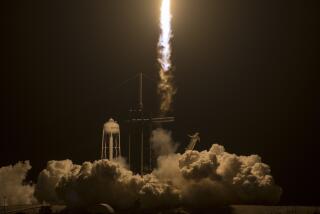Sea Satellites Believed Lost in Titan Blast
- Share via
The spectacular midair fireball that consumed a Titan IV rocket off the Santa Barbara coast this week may have incinerated a trio of secret ocean surveillance satellites designed to monitor Russian surface fleets and nuclear submarines, civilian and congressional space experts said Wednesday.
Pentagon officials still refuse to publicly discuss the secret mission or the cost of Monday’s accident. But a growing consensus of the civilian analysts who monitor the classified U.S. space intelligence system suggests that the rocket may have carried the $800-million ocean satellites, rather than a $1.75-billion Lacrosse radar-imaging satellite as previously believed.
Whichever spacecraft was aboard the doomed $200-million rocket, the Air Force launch accident at Vandenberg Air Force Base--with losses in excess of $1 billion--is the costliest since the Challenger space shuttle disaster and one of the most expensive in spaceflight history.
Air Force officials said Wednesday they still did not know the cause of the explosion. Col. John Hungerford Jr., deputy director for the launch systems program at the Space and Missile Systems Center at Los Angeles Air Force Base, was named to head the board investigating the accident.
In the meantime, the Air Force grounded two other Titan IV rockets with important military payloads awaiting launch from Cape Canaveral. Several officials said it could be as long as a year before the Titan rockets are used again.
One of the 17-story-tall Titans was scheduled to carry into orbit the first in a series of Milstar communications satellites, which are designed to allow military communications even in the aftermath of nuclear war, Pentagon officials said.
The second rocket was to carry a classified payload, which civilian experts believe is a powerful SIGINT satellite designed to intercept radio and telephone signals.
With the rockets grounded and the space shuttle restricted for safety reasons, the U.S. may have no way to launch heavy national security payloads into higher Earth orbits for at least a year, Pentagon and congressional officials said.
One congressional aide suggested Wednesday that, should the need arise, the Pentagon could turn to its former Cold War adversaries for help. “This does open up the possibility of someone using the Russian Energia rocket--a super-heavy-lift vehicle which is sitting over there begging for business,” said the staff member, who requested anonymity.
Although secrecy has relaxed considerably since the Reagan Administration--when the Pentagon followed a formal disinformation policy concerning spy satellites--government officials still almost never discuss U.S. surveillance satellites openly.
So civilian analysts must piece together their picture of the secret military space effort through clues gleaned from budget documents, closed-door congressional testimony, news leaks, gossip and technical data.
“That launch time Monday was a beautiful match for a Lacrosse satellite,” said John Pike, director of the space policy project for the American Federation of Scientists. “It is only by virtue of multiple sourcing and previously unrevealed detail that I am persuaded that the Titan actually carried the ocean satellites.”
More to Read
Sign up for Essential California
The most important California stories and recommendations in your inbox every morning.
You may occasionally receive promotional content from the Los Angeles Times.













